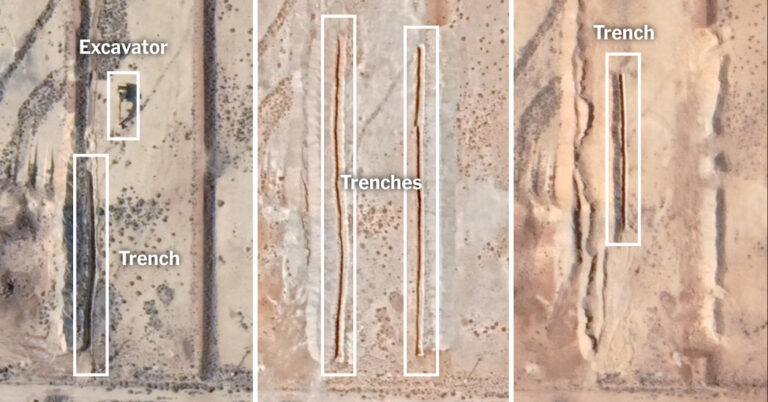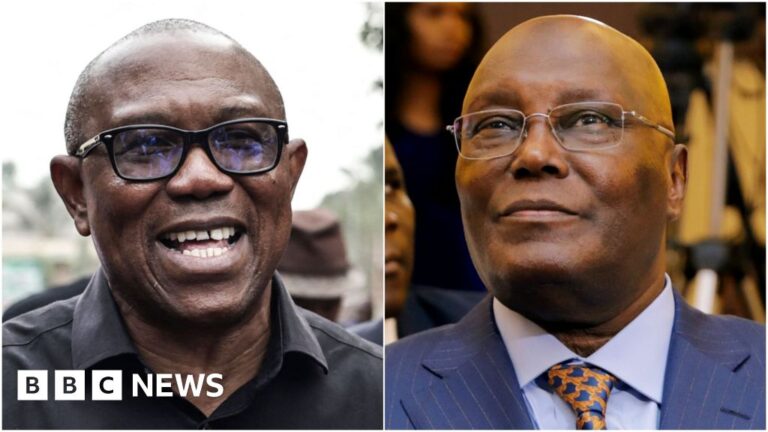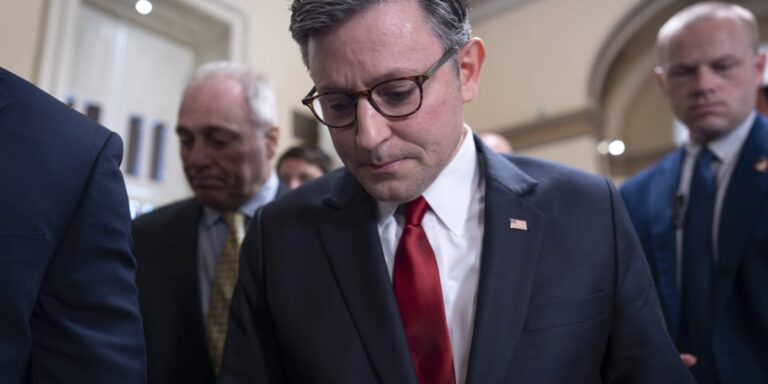The Najha cemetery is about five miles south of Damascus, the capital. It was established decades ago as a modest burial ground for people from Damascus and neighboring towns.
Shortly after the crackdown on the Syrian revolution in March 2011, President Bashar al-Assad’s government began using the cemetery to bury people it killed — many after being detained and tortured in prisons. The regime’s victims included anti-government protesters, activists, journalists; loyalists who fell out of favor; and members of rebel factions.
While the existence of mass graves at Najha was previously known, our investigation reveals — for the first time — how the regime methodically developed the cemetery into one of the country’s largest mass grave sites.
Ms. al-Assad’s intelligence forces initially used empty, existing tombs that had not yet been taken for civilian burials, and then began dumping bodies into crudely dug pits. In more recent years, long trenches were filled with bodies, section by section.
The Times visited the Najha cemetery in February, two months after rebels overthrew Mr. al-Assad’s government.
Times journalists also analyzed satellite images from 2011 to 2024, reviewed photos and videos, and interviewed more than 20 people — including neighbors and former workers who were coerced into taking part in mass burials at Najha. Their accounts are consistent with each other and with what human rights groups have reported about Najha and other mass graves.
There is now a broad effort to identify and locate what are believed to be dozens of mass graves across the country. Najha was identified before the Assad government collapsed. At least 60 total locations have been reported to the White Helmets, a Syrian civil defense group that is leading an effort to excavate the graves.
The Assad government repeatedly denied killing people in detention, but the practice has been documented extensively. The exact number of bodies in mass graves — including Najha — cannot be known until excavations are completed. The Syrian Network for Human Rights estimates that more than 160,000 people who had been held in the regime’s detention centers are still missing.
“The mass graves that we’ve seen so far are bigger than anything we’ve encountered,” said Kathryne Bomberger of the International Commission on Missing Persons.
Bodies were initially piled into existing tombs
2011 – 12
The Assad government began burying the bodies of detainees at Najha in mid-2011, according to former grave workers.
The early mass burials used sites meant for people to bury their loved ones — rows of prebuilt tombs several feet below ground.
But former workers at Najha said that the regime’s officers buried multiple bodies in a single tomb. By using existing sites, the regime was able to keep the initial burials more covert.
Muhammad Afif Naifeh — at the time a clerk at the local mortuary office — said his manager first ordered him to accompany intelligence officials to Najha in mid-2011. There, he witnessed them opening an unmarked tomb and dumping six to seven bodies inside. The same operation was repeated at least twice more in 2011, he said, with the number of bodies increasing each time.
“There were so many decomposed bodies that they started slipping out of the truck,” said Mr. Naifeh, who eventually was forced to manage some aspects of the burial operations. Bodies that were not already decomposed had torture marks on them, he said.
Satellite images analyzed by The Times confirmed signs of mass grave activity — earth disturbances, large vehicles, widespread digging and excavation — in the area described by Mr. Naifeh.
The bodies came to Najha and other mass graves nearby from torture prisons like Sednaya and military hospitals like Tishreen and Harasta, according to reports by human right groups, including the Association of Detainees and Missing Persons of Sednaya Prison.
The Times spoke to a former driver for the Assad government, who said he transported truckloads of bodies from the Harasta military hospital to mass graves and witnessed burials at Najha.
“I thought about leaving, but that would have put my family at risk,” said the driver, who spoke to The Times on the condition of anonymity out of fear of retribution for speaking out. “Every truck driver had to follow orders,” he added, because the Assad government was “merciless.”
As killings soared, bodies were dumped into deep pits
2012
By 2012, a year into the civil war, deaths under the Assad regime began to soar. As more detainees were killed, the government ramped up its mass burial operation at Najha.
Rather than use existing tombs, intelligence forces coerced local municipal workers to dig pits, some nearly 10 feet deep. Among them were Ragheb Turki Mihzah and Youssef Ubayd, who at the time drove heavy machinery for the Damascus governorate.
They said that intelligence officers directed workers to fill the pits with hundreds of bodies that arrived in 50-feet-long refrigerated trucks typically used to transport produce.
In precisely the area that both Mr. Mihzah and Mr. Ubayd said they dug with bulldozers, The Times found evidence of deep pits. The dimensions of many pits match Mr. Mihzah’s description.
The burials at Najha took place during early mornings and at night, according to former grave workers. Government forces would clear out anyone who was in the area and guard the entrance. The officials would confiscate grave workers’ phones and threaten to execute them if they refused to do as told.
Mr. Mihzah, 47, said that as bodies overflowed from a pit, an officer once told a bulldozer driver, “Push them down, or I’ll put you with them.”
Ayman Muhammad Khalil, a guard in the part of Najha used by civilians, said that he sometimes noticed signs of fresh dirt that had been turned over in the morning — a sign of recent digging. He was not allowed to be near the mass graves when the government forces were there.
“We were scared to come here,” said Mr. Khalil, who has worked at Najha for almost two decades and believes that some of his missing friends and relatives may be buried there. “They would take away anyone who would stand here.”
Residents who lived next to Najha told The Times they were aware of the mass burials but remained silent for more than a decade, fearing retribution.
Falah al-Za’al, 52, who had a direct view of the graves from his home, lost more than a dozen relatives to the Assad regime, some of whom he believes may be buried at Najha.
He never uttered a word about what he saw. “The fear is like when you’re near to death,” he said.
In recent years, bodies were discarded in long trenches
2018 – 24
Mass grave activity at Najha slowed for a time around 2013 because rebel advances in the area made it difficult for the burials to continue.
With limited access to Najha, the government that year shifted operations to another large mass grave site in Qutayfa, a town about 20 miles north of Damascus. Mr. Mihzah, who worked at both sites, said that at Qutayfa, he and others excavated long and narrow trenches.
The government regained control of the area near the Najha cemetery in 2014. The Times was unable to verify activity at Najha in satellite imagery until years later, but residents said that they saw trucks arriving at the cemetery then.
“I was terrified,” said Mohammad Ali al-Saleh, 48, a farmer who initially fled and returned to his home near Najha in 2014. “We saw the refrigerated trucks, but we couldn’t even get close — we would’ve been killed.”
Beginning in 2018, long trenches, similar to those at Qutayfa, began appearing in satellite images analyzed by The Times. The trenches were much longer than the crudely dug pits from years earlier. The operation at Najha had become more systematic.
The trenches appeared to be prepared months in advance of their use. The diggers tunneled for up to hundreds of feet, so as to not have to come back multiple times.
The Times was not able to interview anyone who worked directly on the trenches at Najha. But a longtime guard, Abdul Aziz, who is known by his nickname Abu Jihad, said that he witnessed small and large trucks arriving at the cemetery from 2018 to 2020. Around 2020, Mr. Aziz said that he and his brother saw exposed body parts in a trench where he suspected a mass burial had just happened.
Younes Adnan, a farmer who lived adjacent to the cemetery, said that he first saw excavators and trucks arriving at Najha in 2011 and was still seeing them as recently as 2024.
“Every now and then, we’d see an excavator coming from afar — we didn’t dare approach,” said Mr. Adnan, who believes his brother is buried in a mass grave. “But when the excavator showed up, we knew something abnormal was happening.”


















